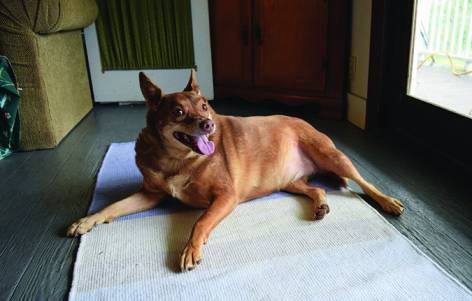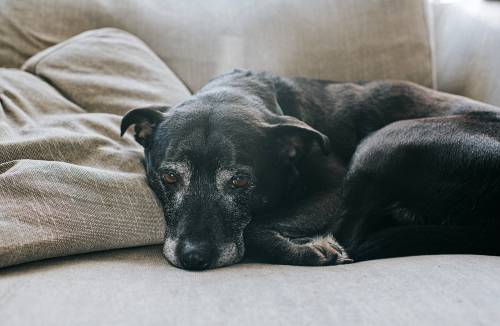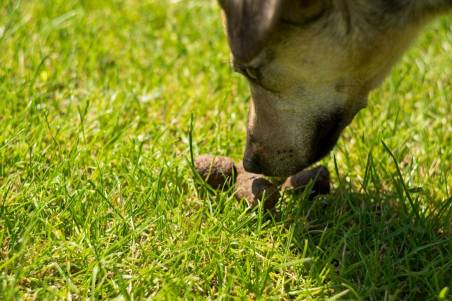Congratulations on your new fur baby! A puppy is a wonderful little creature filled with excitement. Everything is new to them, and it’s so much fun watching them learn and grow as they explore their new world. Along with potty training, and feeding your new fur baby, you’ll need to watch him go through the teething process. Just like human babies, canines go through a teething process. In fact, puppies are born with no teeth!
Connect with a verified veterinarian in minutes. Licensed vets are available 24/7 to answer your questions. No need to worry about your furry family member.
If you’re a new pet parent and have never before gone through the teething stage with a puppy, then you’ve come to the right site. In this short guide, we’ll take you through each step of teething, what to watch for, etc.
Puppy Teething
This is an important stage in your puppy’s life. During this time, he’ll lose his puppy teeth and will develop the grown-up teeth he’ll use for the rest of his life. Puppy teeth are a bit different than a human baby’s teeth. For one, a human baby has 20 milk teeth, and puppies have 28 milk teeth. As an adult, your puppy will go on to have a total of 42 teeth.
A puppy’s first teeth generally start to erupt (come through) the gums when they are around 2-4 weeks old. And all his teeth will come be in place by the time he’s about 6 weeks old. At this age, a puppy doesn’t have molars, because he’s still dependent on his mother’s milk, and doesn’t need to chew anything hard or tough yet. That’s why his teeth are called “milk teeth.”
Puppies Lose Teeth at What Age
Eventually, your puppy will lose his milk teeth. Just like human children lose their teeth, puppies do the same. The milk teeth fall out in order to make room for the puppy’s adult teeth. Not only will the milk teeth fall out, but the puppy will also grow in additional teeth that he needs to chew, shred and tear his food as an adult. Most puppies begin to lose their puppy teeth between 12 and 16 weeks of age. Once the milk tooth falls out, the root of the baby tooth is reabsorbed into the gum. Then the adult tooth begins to erupt, pushing out any remnants of the baby tooth. It can take anywhere from 6 to 8 months to get through the teething stage.
During this period, you may find teeth around your home, in your bed, in your puppy’s bed, etc. Don’t be alarmed! This is all natural and a sign that your puppy is going through the normal process of growing up. On the other hand, if you don’t notice any teeth laying around, it could be your puppy has swallowed them.
This isn’t a cause for concern—it’s natural and the tooth/teeth will not harm your puppy in the least.

Review symptoms, medications & behavior to keep your pets healthy with a Vet Online in just minutes.
Ask a Vet Live NowSchedule of Tooth Loss in Puppies
Here’s a table of when, on average, a puppy will lose his teeth and new ones come in.
| Teeth | Puppy Teeth Age | Adult Teeth Age |
| Incisors | 4-6 weeks | 3-5 months |
| Canines | 5-6 weeks | 4-6 months |
| Premolars | 6 weeks | 4-5 months |
| Molars | None | 5-7 months |
Problems with Losing Puppy Teeth
Problems with losing their teeth is rare in puppies. Needing the help of a vet is very rare. However, some breeds, such as those with short noses (brachycephalic breeds), do sometimes retain their baby teeth. Retained teeth can cause problems such as a malocclusion. Malocclusion is when the teeth are misaligned, which causes a bad bite. This type of issue can cause some discomfort or even lead to problems with your dog’s teeth at some point in the future. For instance, food can become trapped between retained teeth and permanent teeth, leading to cavities and periodontal disease. If your dog’s baby teeth don’t come out, then the vet will need to remove them. This is usually an easy procedure that can be done when you have your fur baby spayed or neutered.
Has your puppy lost all his teeth at once? Puppy teeth falling out all at once is not a common issue. If you notice your puppy seems to be losing several teeth (or more) at one time, then it’s best to call the vet. They’ll check to see if your puppy has any underlying medical issues that could be causing him to lose more than several teeth at a time. Another common problem is puppy teething swollen face. Some puppies may develop a swollen face after they’ve started teething. The issue could be a stick, or a piece of a toy that could have become lodged in between remaining puppy teeth or new adult teeth. Or a piece of a stick could become lodged in the roof of your puppy’s mouth. In this case, it’s time to visit the vet to have the object removed. If it’s not removed early, the stick or other object could start an infection in your puppy’s mouth. You want to avoid this this at all costs.
Puppy Teething Pain
Do puppies cry when teething? In short, yes, it’s possible your puppy may cry when he’s going through the teething process. You may notice some other symptoms including:
- Teeth lying around the house
- Puppy will chew more and more
- Blood on doggie toys
- Whining
- Puppy may run a low-grade fever
- Red/swollen gums
- Increased drooling
- Eating slowly/loss of appetite
As the puppy goes through teething, he may begin to chew on anything and everything. It’s not because he’s being bad or mischievous. Instead, your fur baby is trying to ease the pain and discomfort of the new teeth that are coming in. Dogs are much like human babies when they go through teething. Some human babies will gnaw on wood, metal, or anything hard they can get at. It’s the very same with a puppy.
Chewing and gnawing not only ease the pain, but it helps the teeth to break through the gums, too.
Help for Teething Puppies
First things first, never allow your teething puppy to chew on sticks. These can easily splinter, leading to your fur baby swallowing a piece. Or a piece of the stick could become lodged in his mouth, etc. Instead, it’s better to give your puppy items that are especially made for teething puppies. When it comes to buying a teething toy for your puppy, avoid buying a toy that resembles anything you use or wear. For instance, if you give your puppy a teething toy shaped like a shoe, then your fur baby will believe it’s OK to chew on shoes. You’ll find your favorite hiking boots, pumps or work shoes in shreds. So, avoid giving your puppy anything that resembles something you wear or use. You and your puppy will be happier in the long run!
Stuffed toys are also not a good choice for teething puppies. The toy will easily and quickly be torn apart, leaving puppy to find his next chew toy, which might just be your favorite purse or backpack! Safe teething toys for puppies should be able to withstand hard chewing and gnawing. Even puppies have powerful jaws, especially when they’re in the process of relieving teething pain. However, the toys shouldn’t be so hard that they could damage your canine companion’s teeth.
Great teething toys for puppies include:
Kong Puppy Dog Toy: this is a rubber chew toy that’s safe for teething puppies. The rubber is soft and is made to accommodate a puppy’s changing teeth and gums. It helps to satisfy the instinctual needs and provides mental stimulation at the same time. The toy can help with teething, easing anxiety, weight management, crate training, digging, barking and more. It’s also great for a game of fetch! And you can even put your pup’s favorite treats inside the toy, so he’ll have a challenge that will keep him busy for a time.
Nylabone Puppy Starter Kit Dog Chew Toys: Nyalbone has been a highly favored dog chew toy for years. Their puppy starter kit includes two bone-shaped toys, and one bone-shaped treat, which are gentle on your puppy’s teeth and gums, yet help ease the pain of teething. The bone treat is made of all natural, wholesome lamb & apple flavor. The toys and the treat are all made in the USA.
ZNOKA Pet Products Arctic Freeze Food Cooling Teether: this is a frozen dog teething toy that helps to keep your puppy cooler and makes a great teething ring, too. The ring is made with non-toxic materials and filled with 100% purified water—no harmful chemicals. The ring-shape makes it easy for your fur baby to hold onto the ring as he enjoys chewing. It’s also a great way to help your puppy with separation anxiety. He’ll love chewing on this frozen textured ring!
How to Care for Puppy Teeth
As your puppy goes through the teething process, it’s a good idea to watch him for any kind of teething issues. If he seems to have pain, swelling, loses interest in his favorite activities, loses his appetite, then it’s time to call the vet. Otherwise, now’s the best time to get your puppy used to having his teeth checked. You can brush his teeth, check his gums and teeth, and more. To first begin checking your puppy’s gums, start by raising his lips and touching your fur baby’s gums with your fingertips. Be slow and gentle. Do this at least once or twice a day to get your puppy used to having his mouth checked.
To brush his teeth, start by using your finger to gently brush the puppy’s teeth. If you’d rather not used a finger, then try a gauze pad, as either will work. As you puppy becomes used to this process, you can switch to a doggie toothbrush later. When using a toothbrush, make sure to choose one that has soft bristles and is made for dogs. Also choose a toothpaste that’s used for dogs. Never use toothpaste made for humans, as these may contain ingredients that are harmful to dogs. A doggie toothpaste may include meat flavorings your dog will love. These may make a good option when you start brushing your puppy’s teeth.
Here are some toothbrushes and toothpastes to try with your puppy:
Posh Wag Dog Toothpaste and Toothbrush Set: this set includes a toothbrush with a long, curved handle that makes it easier to reach all areas of your puppy’s mouth. It also includes 2 dual silicon ends that fit over your finger, that are perfect for any size puppy. This kit helps remove plaque, food debris and more to keep your puppy’s mouth healthy.
Arm & Hammer Dog Dental Care Tartar Control Kit for Dogs: this kit is gentle, but effective at removing tartar buildup, making your fur baby’s breath fresher, keeping his teeth healthy and white. The ingredients are all natural—the toothpaste has a great beefy flavor your fur baby will love. The toothpaste is infused with baking soda, which is safe for puppy’s and adult dogs.
As you can see, most of the time your puppy shouldn’t have a problem with losing his milk teeth. His adult teeth should also come in without too much fuss. However, if your fur baby seems to be unusually affected by teething, then be sure to take him to the vet for an exam. It’s possible your fur baby could have something lodged in his mouth, or that his puppy teeth have not completely fallen out.
If everything seems well with your puppy’s teething, then all you need to do is monitor him. And it also helps to start brushing his teeth at this young age. He’ll get used to it, and his teeth will be healthier over the course of his life. In addition, he’ll have better breath. Helping your puppy with appropriate chew toys is a great way to see him safely and comfortably through the puppy teething state.
Connect with a verified veterinarian in minutes. Licensed vets are available 24/7 to answer your questions. No need to worry about your furry family member.

Kim
Kim is a talented author, who loves animals especially dogs. She engaged in writing books and articles relating to animals a decade ago. Kim resides in Chicago with her husband and son. The family is the proud owner of a dog and a parrot (Jack and Lily). Kim wanted more than these two pets, but her husband put his foot down... She often visits elementary schools to talk to the kids about what she learned about pets and how they could learn from them.
Review symptoms, medications & behavior to keep your pets healthy with a Vet Online in just minutes.
Ask a Vet Live Now



